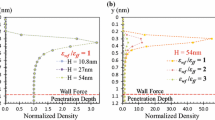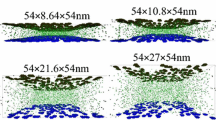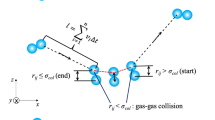Abstract
Using the recently developed smart wall molecular dynamics algorithm, shear-driven gas flows in nano-scale channels are investigated to reveal the surface–gas interaction effects for flows in the transition and free molecular flow regimes. For the specified surface properties and gas–surface pair interactions, density and stress profiles exhibit a universal behavior inside the wall force penetration region at different flow conditions. Shear stress results are utilized to calculate the tangential momentum accommodation coefficient (TMAC) between argon gas and FCC walls. The TMAC value is shown to be independent of the flow properties and Knudsen number in all simulations. Velocity profiles show distinct deviations from the kinetic theory based solutions inside the wall force penetration depth, while they match the linearized Boltzmann equation solution outside these zones. Results indicate emergence of the wall force field penetration depth as an additional length scale for gas flows in nano-channels, breaking the dynamic similarity between rarefied and nano-scale gas flows solely based on the Knudsen and Mach numbers.













Similar content being viewed by others
References
Allen MP, Tildesley DJ (1989) Computer simulation of liquids. Oxford Science Publications, Oxford University Press, New York
Arkilic EB, Breuer KS, Schmidt MA (2001) Mass flow and tangential momentum accommodation in silicon micromachined channels. J Fluid Mech 437:29–43
Arya G, Chang HC, Maginn EJ (2003) Molecular simulations of Knudsen wall-slip: effect of wall morphology. Mol Simul 29(10–11):697–709
Bahukudumbi P, Park JH, Beskok A (2003) A unified engineering model for steady and quasi-steady shear-driven gas microflows. Microscale Thermophy Eng 7:291–315
Barisik M, Beskok A (2011) Equilibrium molecular dynamics studies on nanoscale confined fluids. Microfluid Nanofluid. doi:10.1007/s10404-011-0794-5
Barisik M, Kim B, Beskok A (2010) Smart wall model for molecular dynamics simulations of nanoscale gas flows. Commun Comput Phys. doi:10.4208/cicp.2009.09.118
Bentz JA, Tompson RV, Loyalka SK (1997) The spinning rotor gauge: measurements of viscosity, velocity slip coefficients, and tangential momentum accommodation coefficients for N2 and CH4. Vacuum 48(10):817–824
Bentz JA, Tompson RV, Loyalka SK (2001) Measurements of viscosity, velocity slip coefficients, and tangential momentum accommodation coefficients using a modified spinning rotor gauge. J Vac Sci Technol A 19(1):317–324
Beskok A, Karniadakis GE (1994) Simulation of heat and momentum transfer in complex micro-geometries. J Thermophys Heat Transf 8(4):647–655
Bird GA (1994) Molecular gas dynamics and the direct simulation of gas flows. Oxford Science Publications, Midsomer Norton, Avon, UK
Cao BY, Chen M, Guo ZY (2005) Temperature dependence of the tangential momentum accommodation coefficient for gases. Appl Phys Lett. doi:10.1063/1.1871363
Cercignani C, Lampis M (1971) Kinetic models for gas-surface interactions. Transp Theory Stat Phys 1:101–114
Chirita V, Pailthorpe BA, Collins RE (1993) Molecular dynamics study of low-energy Ar scattering by the Ni(001) surface. J Phys D Appl Phys 26(1):133–142
Chirita V, Pailthorpe BA, Collins RE (1997) Non-equilibrium energy and momentum accommodation coefficients of Ar atoms scattered from Ni(0 0 1) in the thermal regime: a molecular dynamics study. Nucl Instrum Methods Phys Res B 129(4):465–473
Evans DJ, Hoover WG (1986) Flows far from equilibrium via molecular-dynamics. Annu Rev Fluid Mech 18:243–264
Finger GW, Kapat JS, Bhattacharya A (2007) Molecular dynamics simulation of adsorbent layer effect on tangential momentum accommodation coefficient. J Fluids Eng. doi:10.1115/1.2375128
Fukui S, Kaneko R (1987) Analysis of ultra-thin gas film lubrication based on the linearized Boltzmann equation: influence of accommodation coefficient. JSME Int J 30:1660–1666
Fukui S, Kaneko R (1990) A database for interpolation of Poiseuille flow rates for high Knudsen number lubrication problems. J Tribol 112:78–83
Fukui S, Shimada H, Yamane K, Matsuoka H (2005) Flying characteristics in the free molecular region (influence of accommodation coefficients). Microsyst Technol. doi:10.1007/s00542-005-0538-0
Goodman FO, Wachman HY (1976) Dynamics of gas–surface scattering. Academic Press, New York
Gronych T, Ulman R, Peksa L, Repa P (2004) Measurements of the relative momentum accommodation coefficient for different gases with a viscosity vacuum gauge. Vacuum 73(2):275–279
Irving JH, Kirkwood JG (1950) The statistical mechanical theory of transport processes. IV. The equations of hydrodynamics. J Chem Phys 18:817–829
Juang JY, Bogy DB, Bhatia CS (2007) Design and dynamics of flying height control slider with piezoelectric nanoactuator in hard disk drives. ASME J Tribol 129:161–170
Karniadakis GE, Beskok A, Aluru N (2005) Micro flows and nano flows: fundamentals and simulation. Springer-Verlag, New York
Park JH, Bahukudumbi P, Beskok A (2004) Rarefaction effects on shear driven oscillatory gas flows: a DSMC study in the entire Knudsen regime. Phys Fluids 16(2):317–330
Rettner CT (1998) Thermal and tangential-momentum accommodation coefficients for N2 colliding with surfaces of relevance to disk-drive air bearings derived from molecular beam scattering. IEEE Trans Magn 34(4):2387–2395
Sazhin OV, Borisov SF, Sharipov F (2001) Accommodation coefficient of tangential momentum on atomically clean and contaminated surfaces. J Vac Sci Technol A 19(5):2499–2503
Sone Y, Takata S, Ohwada T (1990) Numerical analysis of the plane Couette flow of a rarefied gas on the basis of the linearized Boltzmann equation for hard sphere molecules. Eur J Mech B/Fluids 9:273–288
Steele WA (1973) The physical interaction of gases with crystalline solids I. Gas–solid energies and properties of isolated adsorbed atoms. Surf Sci 36:317–352
Sun J, Li ZX (2010) Two-dimensional molecular dynamic simulations on accommodation coefficients in nanochannels with various wall configurations. Comput Fluids. doi:10.1016/j.compfluid.2010.04.004
Sun J, Li ZX (2011) Three-dimensional molecular dynamic study on accommodation coefficients in rough nanochannels. doi:10.1080/01457632.2010.509759
Tagava N, Yoshioka N, Mori A (2007) Effects of ultra-thin liquid lubricant films on contact slider dynamics in hard-disk drives. Tribol Int 40:770–779
Todd BD, Evans DJ, Daivis PJ (1995) Pressure tensor for inhomogeneous fluids. Phys Rev E. doi:10.1103/PhysRevE.52.1627
Yamamato K, Takeuchi H, Hyakutake T (2006) Characteristics of reflected gas molecules at a solid surface. Phys Fluids. doi:10.1063/1.2191871
Acknowledgment
This work was supported by the National Science Foundation under Grant No. DMS 0807983.
Author information
Authors and Affiliations
Corresponding author
Rights and permissions
About this article
Cite this article
Barisik, M., Beskok, A. Molecular dynamics simulations of shear-driven gas flows in nano-channels. Microfluid Nanofluid 11, 611–622 (2011). https://doi.org/10.1007/s10404-011-0827-0
Received:
Accepted:
Published:
Issue Date:
DOI: https://doi.org/10.1007/s10404-011-0827-0




